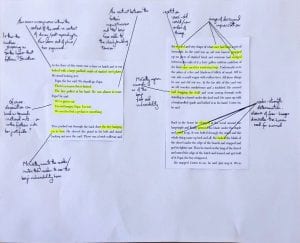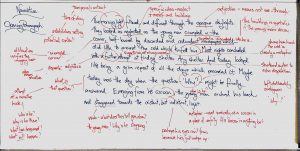Here are the notes from the whiteboard from today’s lesson. Please use them in your planning and preparation for your assessment on the 24th August:
Section One: Short Answer Response Notes
Comprehension section: Suggested 60 minutes allocated for three questions = 20 minutes per question and 200-300 words per question.
Respond in one paragraph in the following format:
INTRODUCTION – 2-3 sentences introducing argument. Restate the question being asked and summarise main point.
P – POINT (Your main idea)
E – EVIDENCE/ EXAMPLE (Direct quotes or indirect quotes [paraphrasing]).
A – ANALYSIS (Elaborate on what you have written to support your answer).
CONCLUSION – 2-3 sentences concluding your answer.
Step One: Deconstruct the Question
Analyse how the man and boy’s relationship with the world is represented in this extract.
Step Two: Plan
Step Three: Write
INTRO: In Cormac McCarthy’s novel, The Road, conflict between the man and the boy occurs in moments where their contrasting perspectives of the world around them becomes clear. The man has memories of the old world, unrecognisable to the boy, whereas the boy is a creature born into this world of chaos.
POINT: Despite the narrative constructing an ever-present familial bond between the man and the boy, they are challenged as they encounter a multitude of moral dilemmas in the apocalyptic landscape in which they seek to survive.
EVIDENCE: An example of this complex relationship is:
1. In the interactions between the man and the boy after the man shot the person from the convoy in the woods. The boy asks, “Are we still the good guys?” (p.80).
- “A formless music for the age to come. Or perhaps the last music on earth called up from out of the ashes of its ruin” (p.81).
ANALYSIS:
1. This demonstrates the way that the man often blurs the lines between being a “good guy” and a “bad guy,” because of his dedication to his son. The boy questions their morality, because of the murder, but the man feels justified, as his priority is the safety of the boy.
CONCLUSION:
1. The man and the boy perceive the world differently, because of their relationship with it. The boy sees a clear divide in this world between good and evil, and he judges the actions of the man according to this. The man sees this division in the world, but excludes himself from blame, because of his “good” intentions. The characters’ relationship with the world is shaped by their experiences in it and the man has experienced more hopelessness and loss than the boy can yet imagine.






